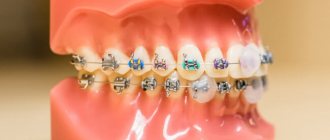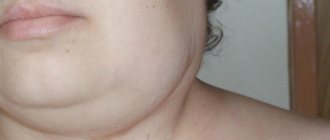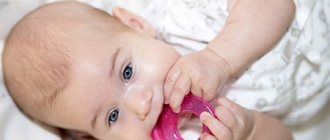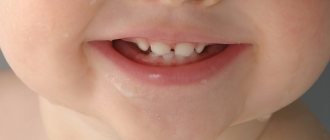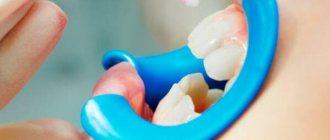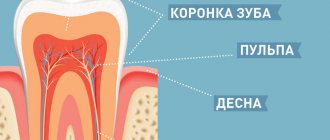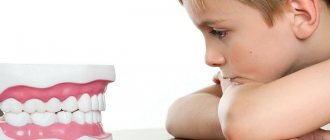Symptoms of teething in infants - how to recognize and respond correctly
Among the important moments in a child’s development, special attention should be paid to the period when the baby is cutting teeth; signs of teething often worry both the baby and his parents. The child begins to cry and worry often, there is often an increase in temperature, and sometimes the child suffers from digestive system disorders. This time will be easier to bear if parents know how the process of teething occurs and what needs to be done to alleviate the child’s condition.
A child is teething: symptoms, how to help a child and what can be done
A few months after the birth of the child, a difficult period of teething begins for him. Experienced parents know how many problems this natural process can bring. During the teething period, the baby is not only capricious, but also has a weakened immune system, which is fraught with infection. Therefore, it is important to be able to distinguish the symptoms that appear when a child is teething from signs of a disease that needs to be treated.
Sequence of teething in children
A newborn child has 20 follicles of primary teeth in the lower and upper jaws, as well as 16 rudiments of permanent teeth (later another 16 rudiments form in the jaws, increasing the number of permanent teeth to 32).
The teeth on the lower jaw begin to appear first. The tooth enamel of children contains more pores and fewer microelements in comparison with the already formed enamel of adults, which contains a large amount of minerals. Therefore, children have a high risk of dental caries, which can be avoided by maintaining hygiene and proper diet, treating teeth with special protective varnishes that will accelerate the mineralization process.
Sequence of baby teeth eruption in children
- 6-10 months – lower central incisors;
- 8-12 months – upper central incisors;
- 9-13 months – upper lateral incisors;
- 10-16 months – lower lateral incisors;
- 13-19 months – upper first molars;
- 14-18 months – lower first molars;
- 16-22 months – upper canines;
- 17-23 months – lower canines;
- 23-31 months – lower second molars;
- 25-33 months – upper second molars.
Timing of permanent teeth eruption
- 6-7 years – upper and lower first molars, lower central incisors;
- 7-8 years – upper central and lower lateral incisors;
- 8-9 years – upper lateral incisors;
- 9-10 years – lower canines;
- 10-11 years – upper first premolars;
- 10-12 years – upper second premolars and lower first premolars;
- 11-12 years – upper canines and lower second premolars;
- 11-13 years – lower second molars;
- 12-13 years – upper second molars;
- 17-21 years old – lower and upper third molars (wisdom teeth).
Deviations during teething in infants
Delayed eruption may occur in a baby due to previous illnesses or illnesses suffered by the child’s mother during pregnancy. Such diseases cause deformation of the jaws and lead to a lack of space for another tooth or teeth to appear.
Treatment in this case is selected individually after examining the child’s teeth and jaws, as well as analyzing an x-ray.
Early eruption is also considered a deviation from the norm. Teething before 4 months is considered a violation, but this is not any pathology for the baby. An extreme form of early teething is when a baby is born with a set of baby teeth.
Deviation from the order of teeth eruption and asymmetry of teeth eruption are considered the most significant symptom of possible deviation from the norm than early or late eruption. Despite this, often this disorder is not the cause of any pathologies in the baby’s body, and may be the norm for a particular child.
Enamel hypoplasia can be determined visually: on newly emerged teeth you can see spots (white, brown or dark brown), horizontal grooves or stripes, and minor depressions (pits). This pathology is associated with abnormalities that arose during pregnancy or childbirth.
Symptoms when a child is teething
It can take about two months from the beginning of the active formation of a tooth to its appearance on the surface of the gum. You can notice the preparation of a child’s body for the appearance of teeth by the following signs:
Gums before eruption
The gum becomes inflamed due to injury from a growing tooth, its surface becomes red and swollen.
- The discomfort that “develops” in the gums is accompanied by increased salivation. There is so much saliva that you have to change your baby's blouses or bibs several times a day because they get wet.
- To relieve itchy gums, the baby instinctively puts things in his mouth and chews on any objects, including his own hands.
- Discomfort prevents the child from eating normally, so his appetite decreases. The rate of weight gain may slow down.
- At night, the itching continues to plague the baby, so his sleep becomes restless and is often interrupted by crying.
- Signs reminiscent of an intestinal infection: frequent regurgitation and diarrhea, in some children - constipation.
- Symptoms suggestive of a respiratory infection include cough, runny nose and fever.
- Sometimes a rash appears on the cheeks.
- Immediately during teething, blood appears on the gums.
Immediately before the crowns emerge on the surface of the gums, the symptoms intensify and new signs are added:
The appearance of lower incisors and molars is accompanied by less noticeable symptoms. If the upper teeth or canines are exposed, the discomfort may be more painful due to their anatomical features.
Signs of teething in children
Often, during the process of teething, children experience general malaise. One of the obligatory symptoms of teething is excessive drooling, which usually occurs at 5-7 months of age. The child cannot yet control the secretion of saliva. Over time, its amount will begin to decrease due to the development of reflexes. Excessive salivation is a sign that the nerves of the gums are irritated, which means that the child will soon erupt his first tooth.
Pain is the surest and most unpleasant sign of teething for a baby. Pain in the gums bothers the child, especially when the tooth approaches the surface of the gums. Often during this process the child’s temperature rises to 37.5 degrees.
Dysfunction of the digestive system is often observed during teething. Symptoms such as diarrhea, vomiting, and regurgitation can occur due to an increase in the volume of liquid that the child consumes during the day. However, there is a risk of not noticing an acute intestinal infection, the likelihood of which is quite high, since a teething child puts various objects in his mouth, which are not always clean. It is recommended to take your child to the doctor if the above symptoms appear.
Gum inflammation is one of the most common signs of teething in a baby. Redness and inflammation of the gums occur, and they begin to swell. These signs indicate that the tooth is already approaching the surface. However, the process of teething is quite long, and this does not mean that if the child has gum inflammation, the first tooth will appear the very next day. The tooth first passes through hard bone tissue, then breaks through the gum mucosa, and only after that can you see a white bump on the surface of the gums, which is a sign that the tooth is about to appear.
Sometimes children experience bad breath during teething. This may be a consequence of the inflammatory process. The oral cavity provides good conditions for the emergence and proliferation of bacteria that cause this symptom. To get rid of bad breath, you should pay special attention to the oral hygiene of a teething child. You can gently massage the gums with a soft brush, and give your child water to drink more often.
Rashes sometimes appear on the body. Due to increased salivation, the rash most often appears on the chin. Also, a rash can occur on various parts of the skin; redness of the child’s face or cheeks is observed.
Due to infection in the mouth, the child may develop stomatitis. Small but painful ulcers may form in the baby's mouth. With this disease, children begin to refuse food and an increase in temperature is observed. In this situation, even though the child will be in pain, it is necessary to examine the baby’s mouth and find out if there are any areas affected by infection.
First teeth. What awaits parents?
The process of the appearance of the baby's first milk teeth is associated with great stress. From strong physical stress, he quickly gets tired, sleeps poorly and eats little.
Read also: Teething and vomiting
Baby's first teeth
This cannot but worry parents, who manage to come up with a bunch of much more serious reasons for concern. Children can wake up several times a night, cry, and wake up their parents. It also happens that they completely refuse to fall asleep in the crib.
- The baby may cry, refuse the pacifier, or suck his fingers. All these signs are not a cause for great concern.
- During teething, salivation increases in the mouths of young children.
Signs of teething
Diarrhea in infants during teething
There is one important nuance in this situation. During this period, children put any objects into their mouths, which are not always clean. This leads to the presence of bacteria in the intestines, leading to infectious manifestations. They are the most difficult to diagnose against the background of general symptoms. Therefore, if you have diarrhea, it is not necessarily a symptom of teething.
The most typical manifestation is inflamed gums. They begin to turn red and swell long before the tooth passes through the bone and then through the soft gum tissue.
Gums before teething
Cold-like symptoms may also appear. Sometimes it's limited to a runny nose. This usually lasts for several days, and then the child’s body copes and successfully resists.
Remember that at this time the immune system is poorly developed, so harmful bacteria multiply massively in the mouth. Let your baby drink more, massage his gums with a soft brush. If there is an unpleasant odor from the mouth, this is also a sign of similar processes in the oral cavity. Don't forget the importance of hygiene.
The stronger the salivation, the higher the likelihood that rashes may appear on the baby's chin. The rash can also be found in other areas. However, you should rule out an allergy to any product.
During the process, the child’s cheeks turn red, and other atypical manifestations may appear. Stomatitis is also not uncommon. The reason for it is the same as for intestinal infections - numerous foreign objects that end up in the child’s mouth.
Be sure to check for any ulcers in your baby's mouth. If a white coating or blisters appear on the tongue, this is a clear sign that he has one of the forms of stomatitis. The feeling is very unpleasant. It is very difficult to eat normally. Because of this, children’s appetite becomes much worse.
Baby with pacifier
While teeth are being cut, the child does not eat well, which affects the process of increasing his body weight. But this is not the biggest problem. Much worse is that the already fragile immune system weakens. During this period, the risk of contracting an infection becomes much higher.
The more worried the baby is, the more worried the parents are. It is difficult to calmly respond to the screams and cries of a child. And if high fever or diarrhea is added to all this, moms and dads begin to panic, call the local pediatrician, and sometimes even call an ambulance. Of course, I am not calling for ignoring such phenomena, but one should not panic either. If you suspect any serious illness, consult with specialists.
Increased temperature during teething in children
How to make teething easier
In order to make the difficult process of teeth appearing easier for your child, you should pay special attention to the child’s oral hygiene and follow the necessary regimen:
- Until 1-1.5 years of age, it is necessary to wipe the baby’s teeth with a special silicone brush;
- From the age of 1.5 years, start using a special children’s brush;
- From the age of 2, teach your child to rinse his mouth after eating.
When the child reaches one year of age, it is necessary to visit the dentist.
It is also necessary to remember that children pay special attention to the behavior of their parents, especially their mother. You can make the teething period easier by giving your child as much attention as possible. It is recommended to carry the baby in your arms more often, talk to him, and distract him with toys.
Babies who are breastfed try to contact their mother's breast as much as possible when teeth appear. During this period, you should not adhere to a strict feeding schedule for the child: the child should be fed as often as he asks for it. This will reduce the infant's irritability.
During the appearance of the first teeth, the child also needs teethers. This helps relieve gum irritation. Sometimes children refuse special teethers, preferring a regular toy. In this situation, you should be especially careful to ensure that the toy is always clean, without sharp corners or small parts, to avoid infection or accident.
Various medications or folk remedies can also help alleviate the symptoms of teething, which can be used in consultation with a doctor. In addition, it is necessary to frequently wipe away the saliva that accumulates near the mouth. If a teething baby experiences vomiting or diarrhea, the baby should be given liquid pureed food and drink enough liquid.
The following folk methods should not be used when cutting a baby’s first teeth:
- Press on the gums with your finger, while applying force. This will cause increased pain and irritation for the child.
- Giving your baby dried bread or cookies: there is a risk of choking on crumbs. In this case, it is better to use safe teethers.
- Treat the gums with undissolved soda or try to free the tooth yourself: in this case, there is a high risk of infection, which will only harm the child.
A child is teething: what to do and how to help your child
It is difficult for a baby to tolerate the discomfort caused by teething. But parents can help their child when he is teething:
Any teething toy or soft rubber brushes, which are placed on the fingers of an adult and used to massage the upper and lower jaws, can help get rid of annoying itching. It is necessary to monitor their integrity so that the child does not swallow the bitten off piece. Mom can massage her gums herself with her fingers, after washing her hands with soap and rinsing thoroughly with water. If the itching is extremely severe and prevents the child from eating and sleeping, you can use children's gels to relieve gum pain: Cholisal, Kalgel, Kamistad.
Read also: Cavity is
the first teeth are always associated with children's whims and the concerns of parents. If a baby is teething, mothers and fathers should treat him patiently, because at his “young” age the baby experiences very severe discomfort, especially when a runny nose, indigestion and frequent nausea appear. You should regularly examine the baby's mouth so as not to miss the development of complications or delayed eruption and, if necessary, begin treatment on time.
Eruption of the first teeth in infants: photos of gums and possible difficulties
In rare cases, the eruption of baby teeth is not accompanied by obvious discomfort.
All parents are looking forward to these first and quite serious changes in the life of their beloved baby with impatience and excitement.
It is important to know what symptoms accompany this process and how to identify changes occurring in the gums.
What does the gums look like when the baby’s first teeth erupt (there are many photos of infants’ gums in the article)? What should parents do if her color turns white, blue or black?
Should I consult a doctor if there is a bruise or hematoma, swelling, inflammation or even blood before eruption?
What gums look like
Long before the first incisors appear , significant changes in muscle tissue can be observed - the main sign of changes in the child’s body.
The color of the tissue structures in the gum area changes: they become more loose.
In the area where the cobs appear, there is swelling and a slight increase in size of the mucous membrane.
The inflamed gum becomes reddish , but it is also possible that it may acquire bluish, burgundy or purple hues, which becomes a serious cause for concern on the part of parents.
As the cutter approaches the surface, the white spot becomes more distinct and noticeable. The final stage is the release of the cobs from the tissue structures.
The very first harbinger of long-awaited changes in the oral cavity is severe itching in the gum area .
To eliminate unpleasant and uncomfortable sensations, the baby constantly tries to scratch this area with his hands and begins to put toys in his mouth.
What does the swollen upper gum look like during and before the eruption of the first teeth in children, photo:
Swollen gums when the lower teeth erupt in an infant, photo:
Problems and solutions
Swelling and redness of the gums when incisors and molars appear is considered normal and should not cause concern to parents. This process is not always accompanied only by the described symptoms.
Parents are faced with blueness of muscle tissue, the appearance of hematomas and bruises, which causes panic.
To minimize possible complications , it will be useful for caring parents to become familiar with the etiology of deviations from the norm and ways to eliminate them.
Why does pulpitis of permanent teeth occur in children and how to treat it? Details are in this material.
You can learn about the symptoms of pityriasis rosea in children from this publication.
Is it possible to bathe a child with roseola? Our article will answer the question.
Swelling
If a baby under the age of one year has swelling of muscle tissue , then we are most likely talking about the eruption of baby teeth.
The first milk teeth begin to erupt when the baby reaches six months of age. Sometimes - several months earlier, and in some cases - much later.
Other signs also indicate that a child’s gums are swollen during teething. This is an increase in temperature, loss of appetite, general malaise, worsening mood.
Swelling of the gums is a natural process that should simply be endured, providing the baby with proper care and attention.
To alleviate the condition, traditional healers recommend using compresses with infusions based on chamomile , which has an anti-inflammatory effect.
Swollen or swollen gums when the first upper teeth erupt in infants, photo:
blue tint
When cutting through the incisors, you may encounter the appearance of cyanosis - acquiring a blue tint .
Did your baby's gums turn blue when teething? The cause of the symptoms is associated with ruptures of small blood vessels located in the gum, through the tissue structures of which the baby tooth erupts.
Small incisions may be necessary as large amounts of fluid and blood will most likely have accumulated there.
Recommendations for parents
Teething causes discomfort not only for the baby, but also for parents who want to ease the child’s well-being.
To reduce disturbing symptoms, you can use:
- drugs that have analgesic and anti-inflammatory effects;
teethers , accelerating the appearance of the baby tooth on the surface. These are toys that contain gel or water inside.
The child will chew on the teethers and eliminate itching and soreness in the gum area;
antipyretics for gums, which are given when the temperature rises during teething.
Immediately before taking any medications, consult your pediatrician to rule out intolerance to the components of the substance;
traditional medicine (use mint, chamomile, lemon balm, lavender, sage).
Medicinal plants have an anti-inflammatory effect, and decoctions based on them can be used to treat gums with signs of inflammation.
Complications for which you should not hesitate to visit a doctor include the formation of large hematomas, an increase in temperature above 38 degrees, the formation of ulcers, frequent bouts of vomiting or stool disorders, severe cough or the appearance of a runny nose, accompanied by greenish mucus discharge.
Is a diet necessary for giardiasis for children and what should it be like? Our publication will tell you about this.
What does prickly heat look like in children in the photo, what treatment is required? You will find answers to your questions in this material.
Read about the causes of urticaria in children in this article.
Advice from Dr. Komarovsky
During this period, it is important to ensure peace for the baby . It is worth temporarily avoiding visiting noisy companies, traveling, and stress, which can aggravate the process.
Vomiting and regurgitation should not be frequent companions. Their appearance is acceptable at high temperatures, but the baby should be shown to a doctor.
To massage the gums, you can use a moistened, rough cloth, or do it with a massage toothbrush. It is important to perform the procedure carefully, without damaging the child’s mucous membranes.
About children's first teeth:
Now you know what gums look like when the first teeth erupt (see photo), how gums swell and swell and why.
Most often, the eruption of baby teeth occurs without serious complications . Parents are required to carefully monitor the condition of the baby’s oral cavity in order to promptly identify and prevent the development of dangerous pathologies.
What to expect
The first teeth appear at about 6 months of age. It may take 2 months from the moment the first signs appear until the tooth appears.
The following symptoms will help you understand that your baby is teething:
- before the teeth emerge, the gums look inflamed and swollen;
- salivation increases;
- the child begins to put all objects and toys into his mouth;
- eats poorly;
- sleep becomes interrupted, often wakes up crying.
The baby's behavior during teething also undergoes changes. The baby becomes capricious, excitable, and often asks to be held.
Does not tolerate harsh sounds or bright light. There are sudden changes in mood: from apathy to an increased desire to be paid attention to.
Signs of teething that resemble the onset of a cold and bowel dysfunction:
- frequent regurgitation;
- the temperature rises to 38 degrees;
- bowel disorder (constipation or diarrhea);
- runny nose;
- cough;
- rash on cheeks.
It is not necessary that all these symptoms will be detected immediately. Some babies may only experience diarrhea, while others may simply drool. When the upper teeth come in, the temperature often rises.
During teething, especially the upper ones, the gums are injured. Therefore, you can see blood on it. It can change the smell of your mouth.
How to care for your child's teeth
Hygiene must be observed even before the child’s upper teeth come in. The gums of infants are cleaned twice a day. To do this, use a clean bandage soaked in boiled water and wrapped around a finger; or a fingertip made of fabric base. After teeth appear, hygiene products should be different. Foams, pastes, toothbrushes - it is important to choose products suitable for children under 4 years of age.
We invite you to familiarize yourself with how stars make teeth: all the methods and methods, medical advice, reviews
Timing of eruption
All children get their first teeth at different times. But already from the 1st month growth begins inside the gums. Teeth can come out early - at 3 months, or they can appear late - at 10-11 months. Most often, the first tooth can be seen at 6 months.
The early appearance of teeth in infants (3 months) is associated with the intake of vitamins and minerals during pregnancy. If teeth appear before 3 months, the child needs to be examined. This may be the cause of endocrine diseases.
Normally, by the age of one year there should be at least 1 tooth. In cases where the teeth do not come out for a long time, the child should be shown to a doctor to rule out developmental pathologies.
Reasons why babies teeth erupt late:
- rickets;
- weakened immune system;
- endocrine disorders;
- unbalanced diet, late complementary feeding;
- premature birth;
- edentia – absence of the rudiments of baby teeth.
The pattern by which the upper teeth erupt in most children is as follows:
| Name of teeth | Appearance time |
| Central incisors | 8–12 months |
| Lateral incisors | 9–13 months |
| Fangs | 16–22 months |
| First molars | 13–19 months |
| Second molars | 2–3 years |
The pattern of teething of the lower row of teeth in many children is as follows:
| Name of teeth | Appearance time |
| Central incisors | 6–10 months |
| Lateral incisors | 10–16 months |
| Fangs | 1.5–2 years |
| First molars | 1.5 years |
| Second molars | 2–3 years |
In some children, the pattern of teeth appearing changes, for example, the canines rather than the incisors emerge first. This is an individual feature that does not bring anything bad.
Consultation with a dentist is necessary when the pairing of eruption is disrupted: one tooth of the pair has appeared, but the other has not, while other teeth are being cut. This may indicate a congenital malformation.
Unpleasant symptoms and pain accompany the period when fangs come out. This is due to the fact that these teeth have sharp, wide and jagged edges.
The upper teeth are often accompanied by a runny nose. This occurs due to the spread of swelling and inflammation of the nasal mucosa. By the age of 3, babies should have 20 baby teeth.
Preventative dental checkups should not be ignored. First visit – at 1 year. Only a specialist can identify oral problems in a timely manner.
Subsequence
In addition to the main symptoms, it is useful to know in what order teeth come in so that you can expect them to appear in the right place. This will be needed when using compresses and ointments. Otherwise, it turns out that they cooled one seemingly swollen area, and an incisor or fang appeared in a completely different one.
- Six months to 8 months - lower central incisors.
- Six months to a year - upper canines.
- 8 months to a year - upper central incisors.
- 9-13 months - upper lateral incisors.
- 10 months-1.5 years - lower lateral incisors.
- 13-19 months - upper molars.
- 1.5-2 years - lower canines.
- 1-1.5 years - lower molars.
- 2-2.5 years - lower second molars.
- 2-3 years - upper second molars.
Parents should also keep in mind which teeth are the most painful to cut on this list. The fangs, with their sharp edges, tear the gums most painfully, thereby causing severe pain to the child. Especially the upper ones, which are called “eye teeth”: they are connected to the facial nerve. And, of course, you need to keep in mind the timing, when to expect all this and how long the whole process will last.
Interesting fact. When one of the identical twins is missing a tooth, most often the other one is missing exactly the same one.
Knowing the approximate dates when the baby should cut certain teeth allows parents to prepare for this phenomenon. If he begins to be capricious and refuse to eat, drool and not sleep, you should not immediately run to the children's clinic - in such a situation you can provide first aid yourself.
From the list given just above, you can see at what age a child starts teething - from six months to almost 3 years. This is an individual indicator and may be shifted by several months. If there are significant deviations from the schedule and this process does not fit into the time frame indicated above, you should definitely consult a doctor. It is not so much the pediatrician who will help here as the pediatric dentist.
Parents often ask how many days it takes their children to teethe so they know when relief will come. This is all again very individual. On average, from 2 to 7 days is considered normal. But the process may take several weeks. This happens extremely rarely, the situation is taken under the supervision of a doctor, and the reasons for such a long process are clarified.
Until what age do children start teething? The main ones (20 milk ones) should appear before 3 years of age. The rest of the indigenous ones - much later, from 6 to 8 years.
The question of how many days it takes to cut the first tooth can be answered in the same way: there is no reason to believe that it will take longer or faster than the others. Expect a few days, but always be prepared for a longer process.
The timing of teething in children can be different, which is determined by the individual characteristics of the body. Everything goes much simpler and easier if they don’t drag on. However, there is one consolation here: even if this whole process lasts for several weeks, its symptoms are not as pronounced as with rapid (2-3 days) teething. The child usually behaves much calmer in such a situation. But in any case, parents should be aware of exactly how they can alleviate his condition.
Read also: When do children grow teeth?
Wow! In terms of strength, human teeth can only be compared with shark teeth.
Giving help
You can alleviate the symptoms of teething with increased attention and affection. You need to pick up the child more often, play with him, talk to him, read books. This is how the baby feels cared for and is distracted.
Adults need to know what activities will help alleviate the condition:
- Proper diet. Avoid sweet foods. It is worth including products such as cottage cheese, cheese, cauliflower.
- As soon as the first teeth appear, they need to be properly cared for. You need to buy a special brush with soft rubber bristles. Your baby should brush his teeth without toothpaste.
- The child should be offered rubber toys, teethers (corrugated or with water).
- Massage the gums with an adult's finger. Be sure to wash your hands with soap before the massage!
- For local anesthesia, gels and ointments are used (Kalgel, Cholisal, Kamistad).
- Antipyretic drugs based on ibuprofen or paracetamol (Nurofen, Panadol).
- You can use decoctions of medicinal herbs (chamomile, lemon balm, mint, sage). They have antiseptic and anti-inflammatory effects. The decoction is taken orally or applied to the gums.
- A solution of soda helps relieve inflammation. To do this, add 1 teaspoon of baking soda to a glass of boiled water. Gauze is wrapped around the finger and moistened with the solution. You can treat your gums several times a day.
- During the period of teething in infants, preventive vaccinations should be excluded.
What to do
The first question that concerns all parents is how to help when their child is teething. This applies to situations where he is in pain and cries incessantly. Various means - medications and folk remedies - will help correct the situation.
Medicines
- Viburcol (Viburkol)
Don't know how to relieve pain? For this purpose, use homeopathic suppositories based on herbal ingredients that have a calming, analgesic and slight antipyretic effect.
- Panadol Baby (children's Panadol)
Parents should know what to do if their child has teething problems and a fever. First of all, call a doctor who will determine the cause of the fever and prescribe appropriate treatment. And before his arrival, you can give Panadol - one of the most popular and effective drugs. The main component is paracetamol. Candles are used for infants, syrup - after a year.
- Nurofen (Nurofen)
Are you looking for something to relieve pain from tearing gums? Use Nurofen - an antipyretic and analgesic suspension with almost instantaneous action. It has a long-lasting effect (up to 6-8 hours). Contains ibuprofen. Not recommended for long-term use.
Pain-relieving ointments and gels are popular when children start teething, but they are not a good choice. With copious salivation, they are quickly eliminated from the mouth, so that the duration of their effectiveness is very short. Feeling local numbness of the gums under their influence, the child may choke or bite his tongue. These drugs include Cholisal, Dentinox, Kamistad, Kalgel, Dentol, Baby Doctor, Pansoral, Traumeel - this is exactly what to smear on the gums in this situation.
Folk remedies
- Ice
Wrap a piece of ice in a sterile cotton cloth and wipe the swollen gum without applying pressure.
If the child is not allergic to honey, rub this product into the gums before bed.
Don't know how to calm a child who is in pain? Let him drink chamomile tea in small quantities 2-3 times a day. You can apply a compress to the gum - a bandage soaked in chamomile decoction. The oil of this medicinal plant can be lubricated on the outside of the cheek where it hurts.
- Chicory root
Give your child chewing chicory root (can be replaced with strawberry root).
Lubricate the inflamed gum with propolis infused in water.
Wipe the gums with mummy solution 2 times a day.
- Frozen fruit
If the child is already on complementary feeding, you can give him small pieces of frozen fruit to chew on - banana, apple, pear.
- Bread products
Bagels, crusts of bread, cookies, and crackers can scratch itchy gums.
- Before teeth appear, clean your gums in the morning and evening with a clean bandage wrapped around your finger and soaked in boiled water.
- Is it possible to bathe a child when teething? If there is no high temperature, it is possible. If it is, it is better to limit yourself to rubbing.
- Use children's anti-inflammatory toothpastes, gels, foams: Weleda, Splat, Splat, Lacalut, Lallum Baby, President, Brush-baby, Silver Care (with silver), Umka, ROCS, Silca, Elmex.
- Don't give a lot of sweets.
- Learn to chew vigorously.
- Include more fruits and vegetables in your diet.
- Visit the dentist 2 times a year.
Now you know how to help a child with folk remedies and medications. They all do an excellent job. If you are not sure about their use, consult your pediatrician or dentist. From now on, you will need to regularly visit the latter’s office to avoid complications.
Scientific data. The tooth is the only tissue that is not capable of self-repair.
Problems that arise with the first teeth
The color of the first teeth can tell about the child's health.
- If the base has a blackish tint, this indicates that you are taking iron supplements. This color can be observed in chronic inflammatory diseases.
- A yellowish-brown tint indicates that the mother took antibiotics during pregnancy, or the child himself during the appearance of teeth.
- A yellowish-green tint indicates blood disorders.
- The red tint appears during a congenital disorder of porphyrin pigment metabolism.
When teeth are being cut, parents can help their child. The main thing is to understand the signs in time and consult a doctor. Care and attention are the best medicines for a baby at this time!
{SOURCE}

